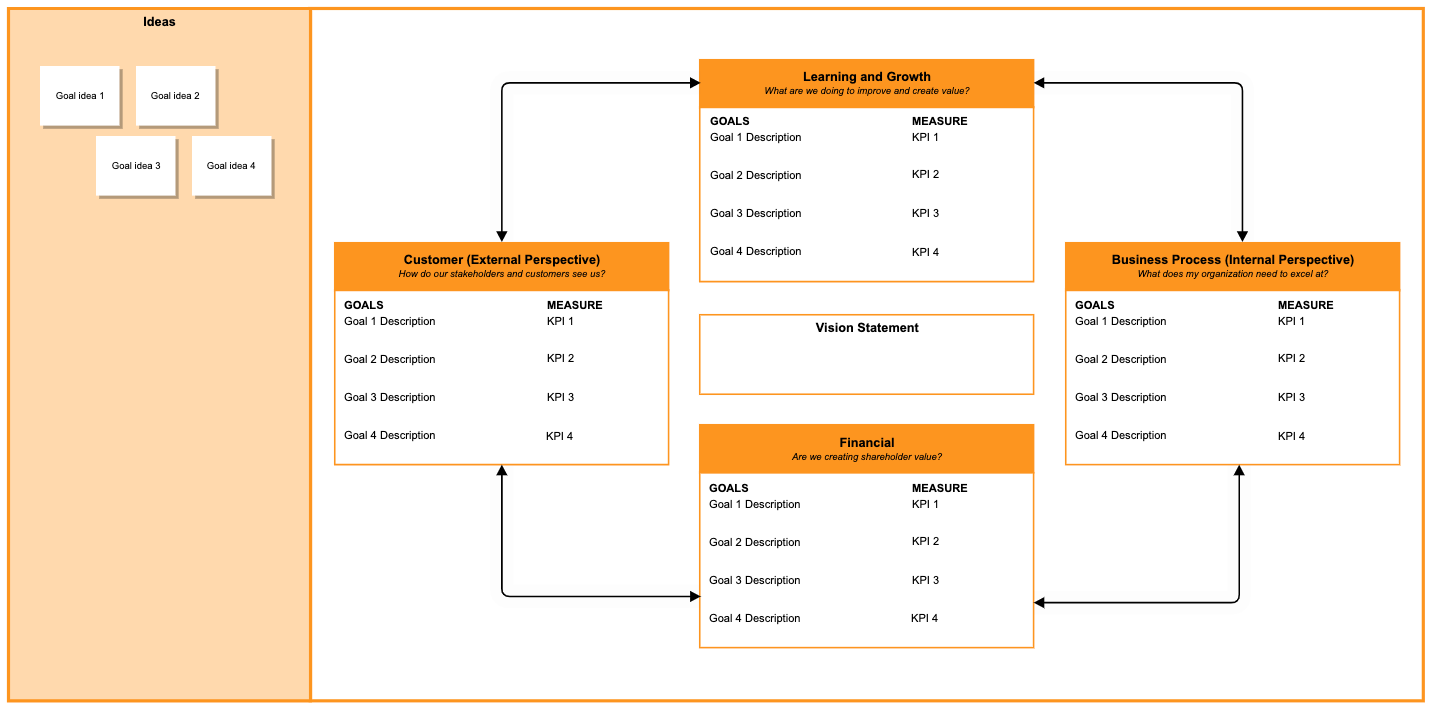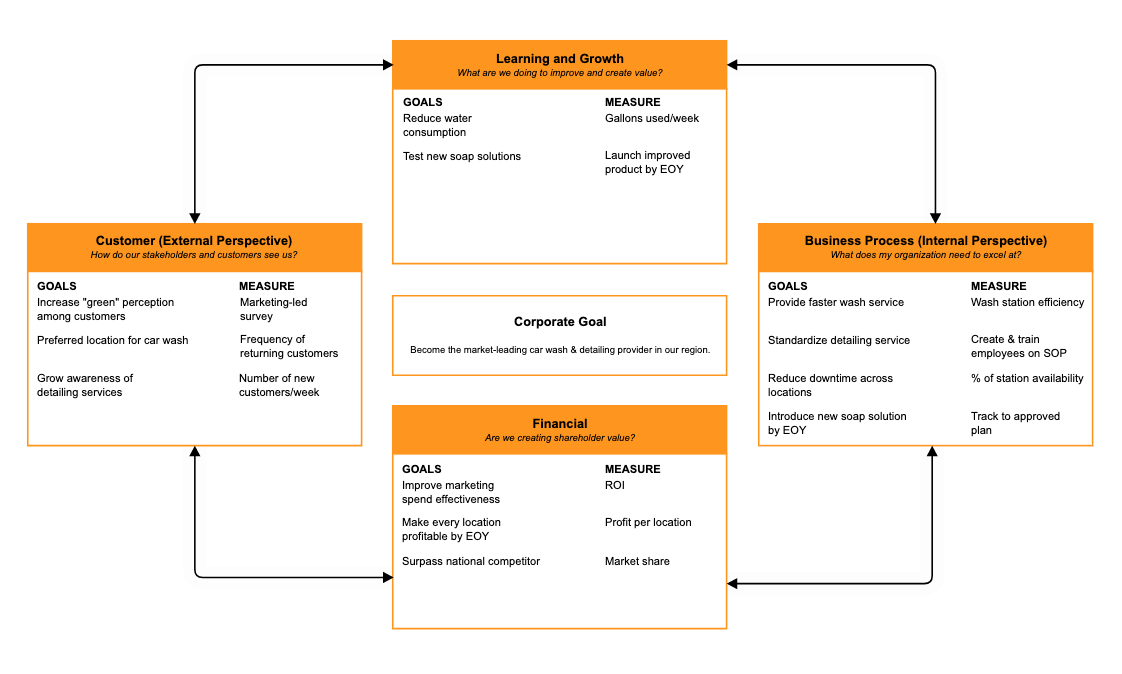What is a Balanced Scorecard?
A balanced scorecard is used within strategic management to help organizations clarify and visualize their strategy. It focuses leaders on specific activities and goals that contribute to the vision and performance of the company.
The scorecard was first introduced by Robert S. Kaplan in the early 1990s and later detailed in the book, The Balanced Scorecard, with co-Author David Norton in 1996.
While other business frameworks like the business model canvas or the strategic planning process help teams articulate a vision for their product or business, these are more performance- and results-oriented. It’s a great way to monitor progress across your company within one concise report.
Start this exercise right away with the template below or jump ahead to one of the following sections to learn more:
Visualize Your Goals with a Balanced Scorecard Template
Use our diagramming app for Confluence to complete your scorecard. This way, you can easily invite others to collaborate and contribute their ideas, track changes, and embed always-updated versions of your scorecard in the tools your team uses most.
 Back to top
Back to top
What are the Four Elements of the Balanced Scorecard?
The four elements included in this framework are learning and growth, business processes, customers, and finance. Each of these elements represents a different perspective, giving managers and leaders multiple lenses to use as they evaluate the business’s performance.
Business Processes
When considering business processes, ask yourself, “What does my organization need to excel at?” Goals included in this section should focus on the day-to-day processes that affect productivity, quality, and output. It can also include goals around implementing new technologies within the manufacturing or production process.
By meeting the goals outlined in this section, your business will be productive and efficient enough to succeed.
Customers
While the business processes element focuses on the organization internally, the customer element represents an external perspective. With this lens, you ask “How do our stakeholders or customers see us?”
Using this external lens is important to ensure that you’re effectively communicating your goals and mission to potential buyers. Customer-focused goals include factors like cost, customer service, and product quality.
Finance
The financial perspective asks, “Are we creating shareholder value?” These goals are typically centered around profitability and revenue growth.
It's important to use this lens because you can improve customer service, product quality, and other elements covered in the business process and customer perspectives without significantly impacting your organization’s bottom line. Including this financial perspective will help you focus on the goals that positively impact your shareholders.
Learning and Growth
This element asks, “What are we doing to improve and create value?” While the lenses described above are important to understanding the current health of the business, innovation is extremely important. Without being able to innovate or improve, companies are likely to stall long-term. Growth activities like introducing new products, entering new markets, and pursuing new value propositions are critical to your organization’s success.
Back to topExample of a Balanced Scorecard
Below is an example of a scorecard for a regional car wash and detailing service provider. Across each of the four perspectives, you can see shared goals and initiatives that all feed into their goal of becoming the market leader in their region.

Notice how reducing water consumption (an innovation initiative) works hand-in-hand with their goal to be perceived as more eco-friendly within the market (a customer initiative). Both of these initiatives can contribute to the financial goal of making every location profitable by the end of the year, as well as growth of the business to become the market leader.
This highlights the strength of this exercise — it ensures that different business units and perspectives align with the highest-level goals for the organization. More importantly, it highlights how different initiatives across business units can support one another.
Back to topHow to Use the Balanced Scorecard Template
The strength of the scorecard is its brevity. It’s a great one-page overview of organization-wide objectives, so it’s perfect for executive teams and monthly meetings.
Step 1: Gather Your Leaders
Implementing a scorecard is going to take in-depth knowledge from across the organization. While consultants and VPs have tried to complete a scorecard on their own, they often find that working with senior managers is important. These leaders have more detailed knowledge of business-unit level goals and priorities. You’ll want their input!
Set aside time to discuss this framework with your leaders. If you’re meeting in person, you can collect ideas for goals and metrics to consider using a whiteboard or sticky notes, but for distributed teams it’s a good idea to use collaboration software like Gliffy.
Tip: To make sure everyone is prepared for the conversation, consider assigning some prework. Other business frameworks like SWOT analysis and value chain analysis can help you better understand the competitive environment and what differentiates key players.
Step 2: Review Your Organization's Vision
Get alignment for leaders by articulating the vision and strategy for your organization. Each perspective within your scorecard should contribute to this vision in its own way.
Step 3: Collect Ideas for the Most Important Goals
With your leaders, discuss each of the four scorecard perspectives (learning and growth, finance, customers, and business processes) and collect ideas for goals that fit within each lens. Aim to identify 2-4 goals for each — those you choose to include should have the highest contribution to your corporate vision and strategy.
Keep in mind that some of these goals may already be in place from the strategic planning process or prior planning exercises, such as gap analysis, or long-term initiatives. This is why it’s so helpful to have representation from across your business. Leaders can tell you what their teams have already been tasked to prioritize or what opportunities their business unit has independently identified.
Collect your ideas by dragging and dropping sticky notes in the panel on the left of our template, then populate the agreed upon initiatives into the four perspectives when you’ve aligned on your organization’s most important initiatives.
Step 4: Set a Metric or Measurement for Each Goal
Agree on how you will measure success for every goal included in the scorecard. Because there are multiple ways to measure many goals, clarifying what metrics you care about before starting to measure is important. For example, if you set an innovation and learning goal of increasing time to market, will you be benchmarking yourself against a competitor or against your performance the prior year?
Step 5: Define Next Steps and Reporting Cadences
With clear goals and measurements in place, you can now expect your leaders to start working toward them!
For each metric, it can be helpful to collect a current-state measurement and use that measurement to set a target. Just as in writing SMART goals, having a specific target allows you to determine whether or not you’re truly meeting the goal. Assign each measurement to the business unit leader whose team will be most hands-on in contributing to that goal and add them to your model later.
Then, determine the follow-up reporting cadence for these goals and measurements. For most organizations, briefly reviewing progress during a monthly executive meeting is appropriate.
Back to topUse Gliffy for Strategizing & Brainstorming
This exercise is a powerful way to align your leaders and ensure your organization delivers on its vision — but it’ll take a lot of teamwork and collaboration to reach your goals. By using Gliffy Diagrams for Confluence or Gliffy Online to capture and refine your ideas, you’ll be able to quickly get buy-in from your most important partners.
Whether you prefer our online diagramming tool or our fully-integrated Confluence app, you’ll get a free trial to get started. From there, it’s all as easy as drag & drop to build out the business frameworks, flowcharts, and concept maps you’ll need to succeed.